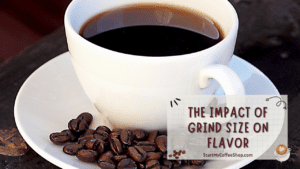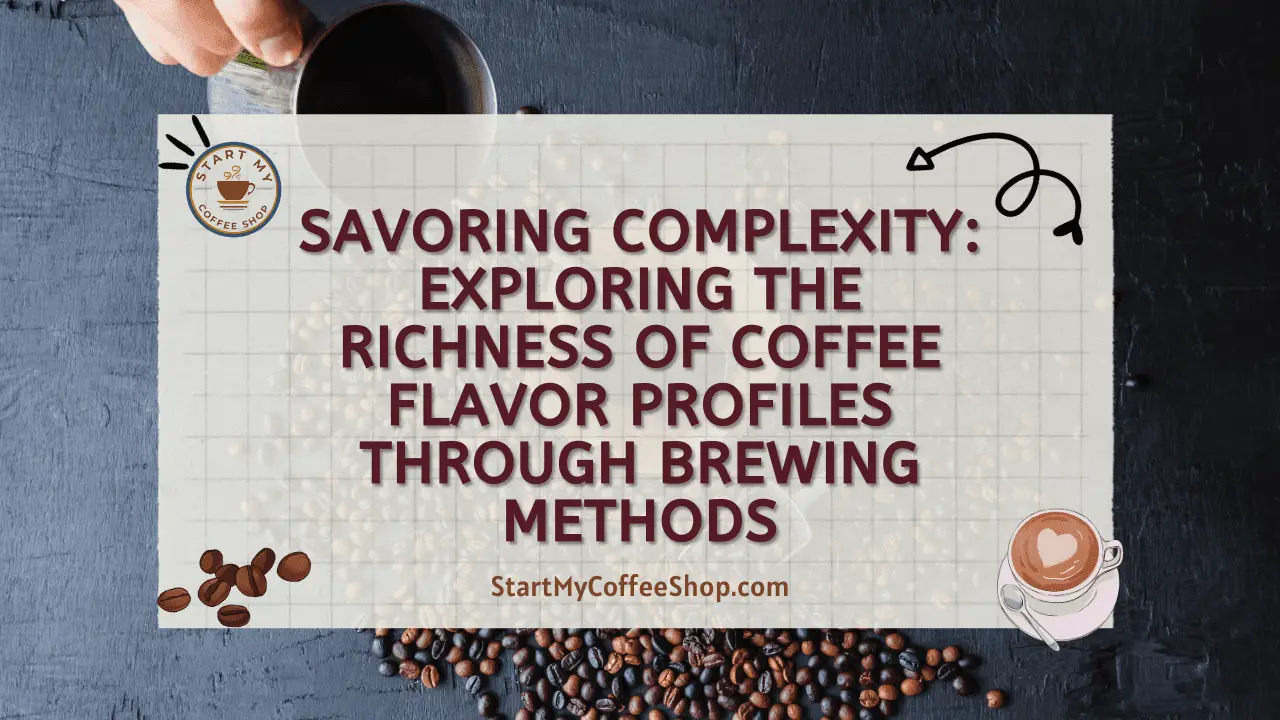Coffee, the beloved beverage that energizes our mornings and accompanies our conversations, is a beverage with limitless potential. Through the art of coffee brewing, its culinary complexities and diverse experiences are revealed. By embracing various brewing techniques, you can embark on a voyage to discover a vast array of flavor characteristics.
The best way to achieve diverse flavor profiles and experiences in coffee is by employing various brewing methods such as pour-over, French press, espresso, and AeroPress. Extraction time, water temperature, and grind size affect coffee’s acidity, body, and aroma, creating unique and complex flavors.
Understanding Brewing Methods

Exploring the brewing techniques that hold the secret to capturing the essence of coffee is crucial before setting out on a path toward a variety of flavor profiles and one-of-a-kind coffee experiences. Pour-over, French press, espresso, and AeroPress are some of the most common techniques; each has unique qualities and effects on the final cup.
The distinctive feature of pour-over brewing is the steady, exact pouring of hot water over the coffee beans. With the regulated extraction made possible by this technique, a clear and complex flavor profile is produced. The gradual saturation of the grounds encourages a balanced taste extraction, bringing out the delicate undertones and subtle variations found in the coffee beans. Pour-over brewing gives coffee lovers the chance to appreciate the subtleties of the beans, enabling them to take pleasure in a classy and distinct cup of coffee.
French press brewing, on the other hand, uses immersion brewing as an alternative strategy. The flavors are fully extracted by steeping coarse coffee grounds in hot water for a long time. Due to the prolonged contact time between the water and coffee grinds, a fuller-bodied cup with rich flavors can be produced with this approach. The resultant coffee is a favorite among people who value a bolder and more pronounced flavor profile since it exhibits a robust character and a particular richness.
Espresso is produced using a special brewing method and is known for being powerful and concentrated. To create a tiny, concentrated shot of coffee, water is forced through finely-ground coffee using high pressure. The fast extraction period used in espresso brewing brings out the strong tastes present in the beans, resulting in a beverage that is flavorful and intense. Espresso offers a unique sensory experience that is unrivaled by other brewing techniques thanks to features like its crema and potent scent.
The AeroPress method gives coffee lovers a flexible and experimental way to extract coffee by combining features of both immersion and pressure brewing. Using air pressure, the brewed coffee is forced through a filter after being steeped in water with coffee grounds. A broad variety of flavor profiles are possible because of the controllable factors that include steeping duration, water temperature, and pressure. A shorter extraction time produces coffee with brilliant acidity and lively flavors, while a longer extraction time improves the body and sweetness of the brew. Coffee prepared with an AeroPress may be adjusted to individual preferences. The AeroPress brewing technique gives coffee enthusiasts the freedom to explore and experiment with various brewing factors, creating unique and intriguing flavor sensations.
Read more about: Growing Coffee Plants: Tips and Techniques for a Bountiful Harvest
The Influence of Extraction Time
Extraction time, a significant factor in coffee brewing, has the potential to significantly affect the flavor profile and general qualities of the finished cup. The amount of time water interacts with coffee grounds is crucial in bringing out the correct flavors and chemicals from the beans. Coffee drinkers can fine-tune their brewing procedures and attain their preferred flavor results by understanding how extraction time affects taste.
By changing the pouring speed and duration when pour-over brewing, the extraction time may be accurately managed. With this degree of control, brewing may be customized to suit each person’s preferences. A shorter extraction time is preferred for people looking for a gentler and more delicate cup. The extraction technique emphasizes brightness and brings out the complex flavors found in the coffee beans by reducing the amount of time that water comes into contact with the coffee grounds. On the other hand, pour-over brewing uses a longer extraction period to draw out a wider variety of chemicals from the grounds, producing a fuller-bodied beverage with stronger flavors.
French press brewing has a longer extraction time and is distinguished by its immersion process. A thorough flavor extraction is possible thanks to the prolonged steeping of the coffee grounds in hot water. The water gently interacts with the grounds during this immersion phase, pulling off oils, acids, and aromatic components. The outcome is a rich and powerful flavor profile in the coffee that is prepared with a French press. In French press brewing, the prolonged extraction period improves the body of the coffee, resulting in a satisfyingly full-bodied and intensely flavored cup.
Espresso brewing is unique in that it takes a different strategy and extracts the coffee much faster than other methods. A quick extraction method is made possible by the high-pressure and finely ground coffee used in espresso brewing. Coffee flavor is swiftly and effectively extracted as water is blasted through the tightly packed coffee grounds, creating a concentrated dose of coffee. With the added benefit of the adored crema, the coating of foam that tops the espresso shot, the quick extraction time results in the strong flavors that are distinctive of espresso.
Coffee lovers have a great degree of time-extraction flexibility when using the AeroPress method. One can experiment with a wide variety of flavors and intensities by changing elements like steeping time and pressure. While lengthier extractions with lower pressure increase the body and sweetness of the brew, shorter extraction durations with higher pressure produce lively acidity and brilliant flavors. Because of this adaptability, people can experiment with different flavor profiles and tailor their extraction to their preferences, allowing for personalization and creativity.
Unraveling the Water Temperature Puzzle
The extraction of tastes and subsequent shaping of the flavor profile of the brewed coffee are both greatly influenced by the water temperature, which is essential to the coffee brewing process. To achieve optimal flavor extraction and prevent unpleasant qualities in the final cup, several brewing techniques have precise temperature requirements.
The optimal water temperature for pour-over brewing is between 195°F and 205°F (90°C and 96°C). The extraction of the required tastes from the coffee grinds while reducing the extraction of bitter chemicals is balanced within this temperature range. While the top limit avoids excessive extraction that could result in an extremely bitter taste, higher water temperatures enable efficient extraction, allowing the flavors to completely develop. Pour-over brewers can generate a well-rounded flavor profile that highlights the subtleties and intricacies of the coffee by keeping the water temperature in this range.
The recommended water temperature for French press brewing is a little lower, usually around 200°F (93°C). To achieve a precise balance between extraction and preventing over-extraction, a lower temperature was adopted. The immersion technique used in French press brewing enables for greater amount of time that the water and coffee grinds are in touch with each other. To reduce the potential of over-extraction, which could produce an excessively bitter and unpleasant cup, the water temperature should be a little lower. In French press brewing, the lower temperature aids in maintaining a smooth extraction, guaranteeing that the flavors extracted are harmoniously balanced and complex.
To achieve consistent and ideal extraction, espresso brewing requires careful temperature control. For espresso, the ideal water temperature range is normally between 195°F and 205°F (90°C and 96°C). Because even little fluctuations in water temperature can result in observable flavor changes, consistency in water temperature is essential while brewing espresso. Water must be the right temperature for the high-pressure brewing process used in espresso machines to extract the correct flavors from finely ground coffee. The extraction process may be dependable and reproducible when the water temperature is kept in this range, guaranteeing that the finished espresso shot maintains its distinctive intensity, richness, and complexity.
Coffee lovers have the option to experiment with a variety of water temperatures using the AeroPress method. Lower temperatures, between 175°F and 185°F (79°C and 85°C), can result in a more vibrant and acidic flavor profile. This lower temperature highlights the coffee’s energetic and vivid acidity, which may be preferred for some beans preferences. On the other hand, higher temperatures, specifically those between 195°F and 205°F (90°C and 96°C), can result in a cup that is fuller-bodied and has a more distinct flavor profile. Coffee enthusiasts can explore the range of tastes by modifying the water temperature while using the AeroPress method, customizing their brewing procedure to reach their preferred taste experience.
The Impact of Grind Size on Flavor

A key element in coffee brewing is the grind size because it directly affects the extraction rate and, as a result, the flavor character of the brewed coffee. Specific grind sizes are required for various brewing techniques to achieve proper extraction and produce a pleasing harmony of tastes in the cup.
A medium-fine to medium-grind size is well-recognized to be preferred for pour-over brewing. With this range, a balanced extraction is possible, avoiding the dangers of either over- or under-extraction. The surface area of the coffee grounds rises with a finer grind size, enabling more effective extraction and boosting the body and intensity of the finished brew. A fuller-bodied cup results from the release of a larger variety of flavors by the finer particles. On the other hand, pour-over brewing with a coarser grind size typically results in a lighter cup with more noticeable acidity. Larger particles slow down the extraction process, resulting in a more nuanced flavor profile that emphasizes the acidity and brightness of the coffee.
A coarse grind size is crucial for making French press coffee. This method’s bigger particle size reduces the possibility of over-extraction, which can result in a bitter and disagreeable taste. Because of the slower extraction time made possible by the coarse grind, the brew is well-balanced and full-bodied. Because there is less sediment in the final brew thanks to the bigger particles, the cup is smoother. Finer grinds in French press brewing may result in more sediment and a more bitter flavor from over-extracting the ingredients. For this reason, maintaining a coarse grind size is essential to obtaining the appropriate flavors and preventing unwelcome bitterness.
Due to its special brewing method, espresso requires a fine and constant grind size. Due to the espresso’s small particle size and quick brew time, extraction is effective. A higher surface area provided by finely ground coffee enables a quick extraction of flavors. A concentrated and powerful espresso shot is created by this fast extraction procedure, and it is distinguished by its intense flavor profile, rich body, and velvety crema. To guarantee uniform extraction, it is crucial to maintain consistency in the grind size when making espresso, as any deviation can dramatically affect the shot’s quality and flavor.
The AeroPress technique gives coffee lovers the freedom to experiment with different grind sizes, allowing them to sample a variety of flavor profiles. A bolder and more intense cup results from an AeroPress grind size that is finer because the smaller particles allow for more flavor extraction. Those looking for a stronger flavor experience might find this appealing. In contrast, a coarser grind size produces a cleaner, lighter brew in the AeroPress method, along with less extraction and a milder flavor. Coffee drinkers can fine-tune their brewing procedure to reach their preferred flavor preferences by modifying the grind size and exploring the full range of options that the AeroPress method allows.
Read more about: Health-Boosting Brew: How to Add Turmeric to Your Coffee
Frequently Asked Questions

Which brewing technique is ideal for someone who enjoys a robust and flavorful cup of coffee?
For those looking for a potent and robust coffee flavor, the espresso brewing method is the best option. Espresso extraction produces a potent cup of coffee by quickly extracting rich and concentrated tastes under high pressure using finely ground beans.
Is the grind size consistent across all brewing techniques?
No, for the best extraction, each brewing technique calls for a particular grind size. While the French press calls for a coarse grind, pour-over normally calls for a medium-fine to medium-grind size. The AeroPress method offers versatility with both finer and coarser grind sizes according to the desired flavor profile, even though espresso requires a fine grind.
How does coffee flavor change as a result of extraction time?
The length of the extraction process greatly affects the flavor of the coffee. Shorter extraction times offer brightness and nuance, whereas longer extraction times typically produce richer, more powerful flavors. Coffee lovers can create a variety of flavor profiles, from robust and full-bodied to delicate and nuanced cups of coffee, by altering the extraction time.
To learn more on how to start your own coffee shop, check out my startup documents here.
Disclaimer: The information provided by StartMyCoffeeShop.com (“The Site”) is for general informational purposes only. All information on the Site is provided in good faith. However, we make no representation or warranty of any kind, express or implied, regarding the accuracy, adequacy, validity, reliability, availability, or completeness of any information on the Site. Under no circumstance shall we have any liability to you for any loss or damage of any kind incurred as a result of the use of the Site or Reliance on any information provided on the Site. Your use of the Site and reliance on any information on the Site is solely at your own risk. This blog post is for educational purposes only and does not constitute legal advice. Please consult a legal expert to address your specific needs. Terms and Conditions. (https://startmycoffeeshop.com/terms-and-conditions/)

Hi! I’m Shawn Chun
My adventure in coffee began when I first launched my first coffee shop back in the early 2000s. I had to figure out so many things on my own and to make it worse within 2 years of opening two large corporate coffee chains moved in just blocks away from me!
As I saw smaller and even some larger coffee shops in the neighborhood slowly lose customers to these giant coffee chains and slowly close up shop, I knew that I had to start getting creative…or go out of business.
I (like you may be) knew the coffee industry well. I could make the best latte art around and the foam on my caps was the fluffiest you have ever seen. I even had the best state-of-the-art 2 group digital Nuova Simonelli machine money could buy. But I knew that these things alone would not be enough to lure customers away from the name brand established coffee shops.
Eventually, through lots of trial and error as well as perseverance and creativity I did find a way to not only survive but also thrive in the coffee/espresso industry even while those corporate coffee chains stayed put. During those years I learned to adapt and always faced new challenges. It was not always easy, however, in the end, I was the sole survivor independent coffee shop within a 10-mile radius of my location. Just two corporate coffee chains and I were left after that year. All told the corporate coffee chains took down over 15 small independent coffee shops and kiosks and I was the last one standing and thriving.
Along the years I meet others with the same passion for coffee and I quickly learned that it is not only “how good a barista is” that makes a coffee shop successful, but the business side of coffee as well.
Hence why I started this website you are on now. To provide the tools and resources for up and coming coffee shop owners to gain that vital insight and knowledge on how to start a coffee shop successfully.
Stick around, browse through my helpful blog and resources and enjoy your stay! With lots of LATTE LOVE!
Shawn







